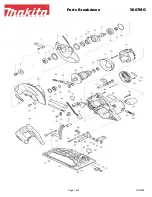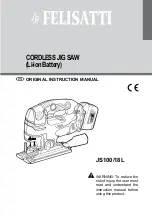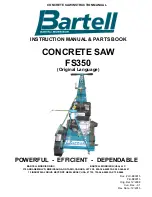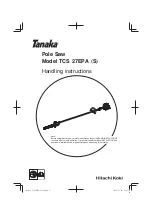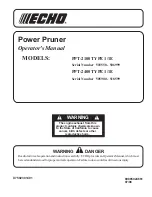
23
ENGLISH
kerf and jump back toward operator.
Kickback is the result of tool misuse and/or incorrect
operating procedures or conditions and can be avoided
by taking proper precautions as given below.
TO REDUCE THE RISK OF KICKBACK
Keep a firm grip on saw with both hands at all times.
Stay alert – exercise control.
Support long overhanging materials. As the material is cut
and weakens, it will sag, causing a pinched blade.
Support large panels as shown
(Fig. 1).
Material
supported only at the ends
(Fig. 2)
will lead to blade
pinching.
Avoid sawing overhead. Material can sag and will pinch
blade.
Keep blades sharp and clean.
Use fence or straight edge guide when ripping. Be careful
as the cut off strip can sag or twist, closing the cut and
pinching the blade, leading to
KICKBACK.
Don’t force tool. Wood variables such as knots, hardness,
toughness, wetness, pressure treated and freshly cut
green lumber can heavily load the saw which can lead to
stalling. Push the saw slower when this occurs.
Don’t remove saw from work during a cut while the blade
is moving.
Allow saw to reach full speed before blade contacts
material to be cut. Starting the saw with the blade against
the work or pushed forward into cut can lead to stalling or
sudden backward movement of saw.
Never attempt to lift saw when making a bevel cut. This
leads to blade binding and stalling.
Always secure work to prevent workpiece movement
during cut.
Do not try to force saw back on line if your cut begins to
go off line. This can cause
KICKBACK.
Stop saw and
allow blade to coast down to a stop. Withdraw from cut
and start a new cut on the line.
Set depth adjustment of saw such that one tooth of the
blade projects below the workpiece as shown in
(Fig. 8).
Do not back up a rotating blade in the cut. Twisting the
saw can cause the back edge of the blade to dig into the
material, climb out of the work and run back toward the
operator.
Avoid cutting nails. Inspect for and remove all nails from
lumber before cutting.
Warning! Some dust created by power sanding,
sawing, grinding, drilling, and other construction
activities contains chemicals known to cause cancer,
birth defects or other reproductive harm. Some examples
of these chemicals are:
lead from lead-based paints,
crystalline silica from bricks and cement and other
masonry products,
arsenic and chromium from chemically-treated lumbe
(CCA).
Your risk from these exposures varies, depending on how
often you do this type of work. To reduce your exposure to
these chemicals: work in a well ventilated area, and work with
approved safety equipment, such as those dust masks that
are specially designed to filter out microscopic particles.
Avoid prolonged contact with dust from power
sanding, sawing, grinding, drilling, and other
construction activities. Wear protective clothing and
wash exposed areas with soap and water.
Allowing
dust to get into your mouth, eyes, or lay on the skin may
promote absorption of harmful chemicals.
Warning! Use of this tool can generate and/or disburse
dust, which may cause serious and permanent respiratory
or other injury. Always use NIOSH/OSHA approved
respiratory protection appropriate for the dust exposure.
Direct particles away from face and body.
Caution! Wear appropriate hearing protection during
use. Under some conditions and duration of use, noise
from this product may contribute to hearing loss.
Snagging the lower guard on a surface below the
material being cut can momentarily reduce operator
control.
The saw can lift partially out of the cut increasing
the chance of blade twist. Ensure there is sufficient
clearance under the workpiece.
When necessary to raise lower guard manually, use
the retracting lever.
KEEP THE BLADES CLEAN AND SHARP.
Sharp blades
minimize stalling and kickback. The use of dull and/or
dirty blades can increase the saw loading causing the
operator to push harder which promotes twisting.
Danger! LACERATION HAZARD. KEEP HANDS AWAY
FROM CUTTING AREA.
Keep hands away from blades.
Never place hands in front of or behind the path of the blade
while cutting. Do not reach underneath work while blade is
rotating. Do not attempt to remove cut material when blade is
moving.
SUPPORT LARGE PANELS.
Large panels must be
supported as shown
(Fig. 1)
in this manual to minimize
the risk of blade pinching and kickback. Material
supported only at the ends
(Fig. 2)
will lead to blade
pinching. When cutting operation requires the resting of
the saw on the workpiece, the saw shall be rested on the
larger portion and the smaller piece cut off.
USE ONLY CORRECT BLADES AND BLADE
ASSEMBLY COMPONENTS WHEN MOUNTING
BLADES.
Do not use blades with incorrect size holes.
ADDITIONAL SAFETY RULES
FOR CIRCULAR SAWS





















